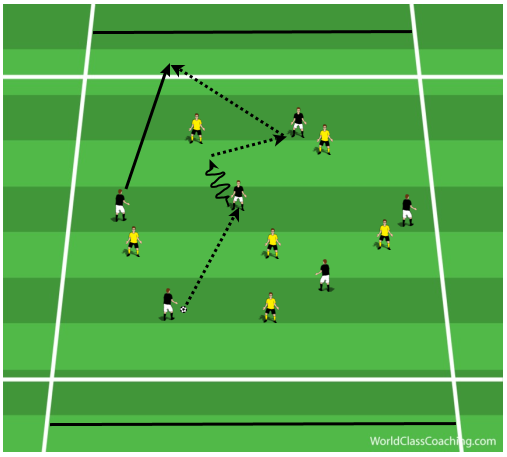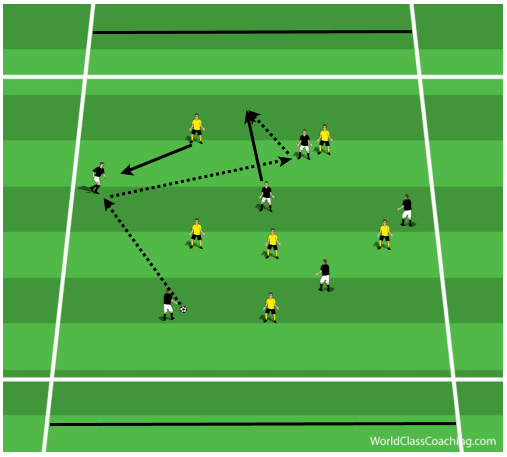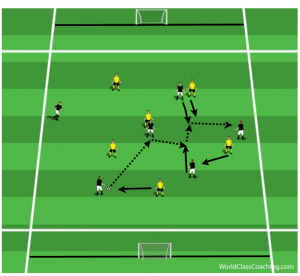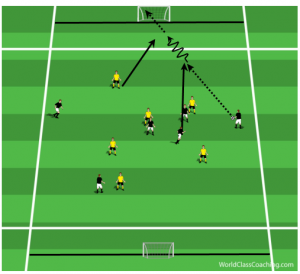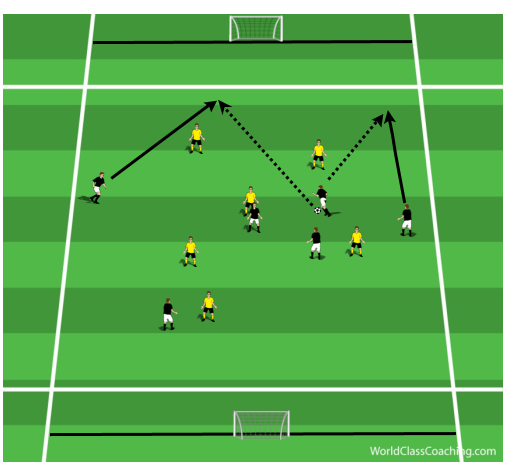By Sean Pearson
Area: 50x35yards
Players: 12
Teams: 2
Length: 20-25mins
This small sided game is very specific in showing your team the forward runs you want them to make and when, whilst in positions they would be during a game if you play in the 4-2-3-1 formation. It also pits two of the same midfield formations against one another.
Objectives
- To be positive/attack minded
- Encourage forward runs off the ball and beyond the striker
- Which player runs forward
The area is split in to 3 zones, one large zones (40x35) with 2 small ‘end zones’ (5x35). In this practice we want a lot of movement from players off the ball into the space ahead of the striker. It is important to know when and where to time these runs. The two teams set up in a 2-3-1 formation and the aim is to either receive the ball or run with it into the end zone the team is attacking.
Wide Midfielders
When a center midfielder (CM) has the ball, the attacking midfielder (AM) looks to get in between the lines of the other team. The wide midfielder (WM) also looks to get behind their WM counterpart. The CM on the ball can drift wider to entice the opposing WM to press, this will give your WM more space. As players begin to press, the CM plays through to the AM who turns and dribbles at the CM. The striker (ST) pulls away and the WM runs behind the CM. If the CM drops and follow the WM then tell your AM to continue to dribble forward. As the AM commits the CM they play around them by passing to the ST who plays a one time pass, ahead of the runner, into the space for the WM to collect.
Attacking Midfielder
Eventually the WM and AM of the defending team will begin to close off the middle to stop the direct ball to the team in possession’s AM. When this happens have the WM pull as wide as possible, as the ball travels the CM will press the WM, if they don’t tell the WM to drive at them. The ST stays on the opposite side of the field so as to keep the middle open. When the CM has committed the WM plays across, the ball can either go directly to the AM in the middle or into the ST and AM carries their run beyond the striker and dribbles into the end zone.
Center Midfielders
This is a more complicated pattern and concept but it is all linked to positions the opposition may now take up to stop the previous two forward runs. If the defending team begins to stop the AM from drifting between the lines and the pass out wide runs come from deeper centrally by the CM’s. Tell the CM on the ball to play to the AM’s feet, the opposite CM steps up to receive the ball (if the WM comes across to stop this, the AM plays out wide to their WM). As the CM comes forward the ST drops to receive the ball, bringing the CM with them, they set the ball at an angle to the WM and the CM carries on their run into the space. The WM then plays the ball into the space.
If the CM does not come with the ST when they drop, the ST can turn (with communication from teammates) and drive at them. The WM closest can run down the line and the WM opposite makes a diagonal run behind the opposite CM, the ST then picks the best option to get in behind.
Variations
- Add a goal (with/without GK), allow onetime finishes to encourage passes in front of the runner or more than one runner.
- With larger numbers add center backs or GK’s
- If the entire defending team steps up to press, play over them with diagonal balls to the opposite WM.
Coaching points - Understand which player should run forward and at what time.
- Pass ahead of the runner so they don’t have to slow down.
- Draw players out of position and attack quickly.
By Sean Pearson
By Sean Pearson. Sean is also the author Coaching Team Shape in the 3-3-1, Coaching Team Shape in the 4-2-3-1 and Coaching Team Shape in the 4-3-3

